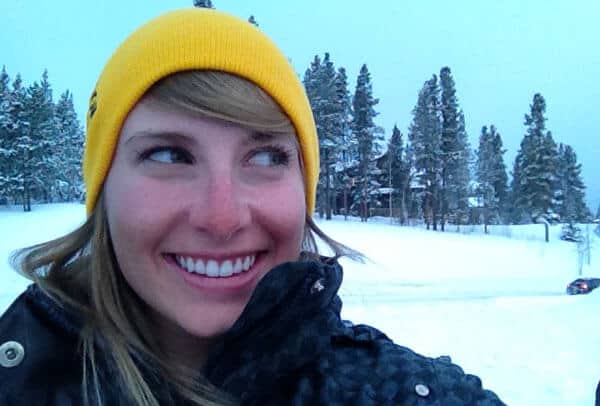
It’s not easy: the moment you steer off the groomed piste and into the deep stuff beyond. Fitness, technique, equipment, snow quality, mental attidute – they all contribute, and often in different ways on different days. So we asked one of the most powder-loving, positive-thinking instructors we know – Shawna Mckeown, from the ski resort of Breckenridge, Colorado – for her three top “How to ski powder” tips. Here’s what she said.
1. Go FAT
Not sure if your skis are right for the powder? Then get a fatter pair. Fat, rockered powder skis are where it’s at right now, and they’re a joy to ski in the deep stuff.
Nothing less than 100mm under foot will do. On a big powder day you’ll find me on the Line Pandora – 142mm at the tip, 115mm underfoot, 139mm at the tail. Having this much ski under your boot may look stupid – but the balance and stability you’ll get from such width will quickly convince you otherwise.
You should look for some rocker in your skis as well. A rockered ski is one that bends or rises more dramatically at the tip and tail – making it easier for the skier to float over the snow, and stay centered over the ski. (There’s a common misconception that rockered skis are impossible to turn on groomed snow, but if you get a pair with side-cut – a difference of about 20mm between the tip, waist, and tail – you’ll find the groomers a lot easier.)
2. Don’t Sit Back
Don’t lean back on your skis. Stop, lean forward, charge that mountain! New powder skis are built to tackle steeps and bumps head on, so why try to stop them? The technology is there to help. The rocker will make you float, the fatness will give you balance – all you have to do is learn to trust them both and they will change the way you ski!
(Editor’s note: see Shawna’s clarification about “leaning forward” at the bottom of this feature. She’s talking about getting off the tails of your skis, so that you’re centred and balanced over the middle of them, not about leaning forward over the tips.)
3. Seek Out Your Line
There’s a big difference between seeking out a line and merely following one. Seeking is more active, more dynamic and ultimately more aggressive – and that’s crucial when it comes to skiing steep backcountry slopes, because the more hesitant you are, the more you’ll settle back on your skis and the less control you’ll have over them as a result.
By actively seeking out your line, you’ll change your mentality towards the slope, and your stance should improve as a result. You’ll be moving our weight forward, charging downhill, and finding your skis are much more manoeuvrable.
Actually, this approach works whether you’re learning how to ski on steep groomers or in the powder, so try it the next time you’re out, whatever the conditions. Remember – look ahead when you ski, and seek out your line!














Advising skiers to “lean forward” is probably the worst piece of instruction ever. Leaning forward is worse than leaning back, try it and you will soon find out. Being centred and balancing dynamically is what is required in all forms of skiing. This is what Shawn actually means but like many instructors she needs to think more about the words she uses when explaining to students.
Dear Steve,
Thank you for the comment. It’s true that the ideal stance for any skier is to be centered and balanced over the middle of our skis. The goal of what I am trying to get across here is not to lean back. In my experience, conveying the idea of forward movement, and charging downhill to my students, brings most people off the tails and over the center. I hope this helps to clarify.
Shawna.